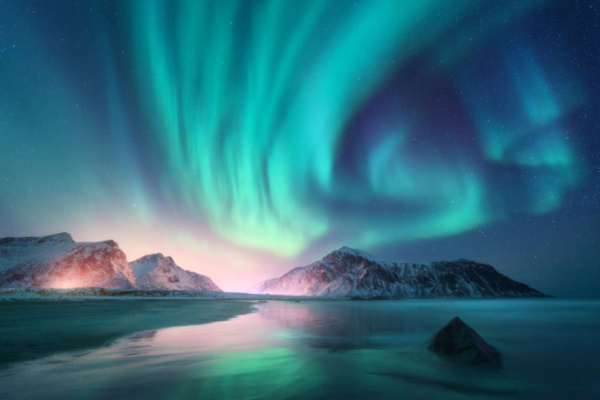As aurora watchers waited and wondered Thursday night, for a time it seemed possible the latest blast from the sun could end up a northern lights bust. But then, there was light.
As The Washington Post reports, a geomagnetic storm reaching G3 levels, which is considered strong on a scale of 1 to 5, roared in shortly before the sun began to rise Friday morning on the East Coast, arriving several hours later than expected. Colorful aurora borealis were reported at least as far south as Arizona in the United States, with vibrant displays reported at higher latitudes, and there could be more to come. The Southern Hemisphere has also checked in with its own dancing lights in the sky.
The display came after the sun sent four bursts of plasma, known as coronal mass ejections or CMEs, hurtling toward Earth earlier this week. Space weather forecasters had expected three of the blasts would combine into an intense “cannibal” CME that could trigger auroras unusually far south into the United States and Europe.
Delayed, but not denied
Satellite observations showed limited sign of enhanced auroral activity early Thursday evening. The first hint of a storm arrived later in the evening, but even then only as a minor ripple in the atmosphere. Then a prolonged lack of notably colorful skies much of the night caused those awaiting northern lights to become increasingly anxious. However, the most patient and persistent of sky watchers were rewarded in the end.
The strong geomagnetic storm got underway around 5:45 a.m. on the East Coast of the United States. It ramped up to G3 by 6:30 a.m. and, as that happened, an eruption of red and green pillars in the sky became visible to the naked eye much farther south than usual.
So far, reports of auroras have come in from as far south as Arizona. Nebraska, Iowa. Connecticut and Massachusetts also caught a glimpse, in addition to the typical spots in more northern reaches. Even with a moon nearly 90 percent illuminated, just days after a full moon, the colors shined brightly. Despite some delay in the onset of northern lights, forecasts ended up fairly accurate in the end. Space scientists had been expecting a strong geomagnetic event for days.
The most intense solar storms can cause significant disruptions on Earth, including blackouts in radio communications and global positioning satellites, or even power systems more broadly. Storms of G3 intensity tend to produce only minor impacts to technological infrastructure while often producing shows of brilliant auroras.
How long will the solar storm last?
The multiple CMEs may allow auroras to be more prolonged than in most space weather events. While uncertain, it’s possible that the ongoing storm will persist into Friday night for the United States. In the meantime, other regions may witness dazzling displays, as night returns to Asia and Europe.
The sun continues to move through an active spell over recent months and years. November featured a strong G3 storm in which northern lights were visible on long exposure imagery as far south as Texas. Earlier in the year, a severe G4 storm struck. It was the strongest since 2017.
Additional bursts of geomagnetic activity are a good bet in the months to come as the solar cycle reaches its peak in 2024.
—
Photo Credit: Denis Belitsky / Shutterstock.com
